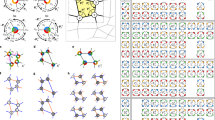Abstract
Robert Lang’s Universal Molecule algorithm, a landmark in modern computational origami, is the main component of his widely used TreeMaker program for origami design. It computes a crease pattern of a convex polygonal region, starting with a compatible metric tree. Although it has been informally described in several publications, neither the full power nor the inherent limitations of the method are well understood. In this paper we introduce a rigorous mathematical formalism to relate the input metric tree, the output crease pattern and the folded uniaxial origami base produced by the Universal Molecule algorithm. We characterize the family of tree-like 3D shapes that are foldable from the computed crease patterns and give a correctness proof of the algorithm.
Similar content being viewed by others
References
Aichholzer, O., Alberts, D., Aurenhammer, F., Gärtner, B.: A novel type of skeleton for polygons. Journal of Universal Computer Science 1(12), 752–761 (1995)
Bowers, J.C., Lang’s universal molecule, I. Streinu.: algorithm. In: Proceedings of the Twenty-eighth Annual Symposium on Computational Geometry, SoCG ’12, pp. 419–420. ACM, New York (2012)
Bowers, J.C., Streinu, I.: Rigidity of origami universal molecules. In: Ida, T., Fleuriot, J. D. (eds.) Automated Deduction in Geometry, vol. 7993 of Lecture Notes in Computer Science, pp. 120–142. Springer (2012)
Bowers, J.C., Streinu, I.: Computing origami universal molecules with cyclic tournament forests. In: Proceedings of the 15th Intern. Symp. on Symbolic and Numeric Algorithms for Scientific Computing (SYNASC’13), pages 42–52. IEEE (2013)
Demaine, E.D., Demaine, M.L.: Computing extreme origami bases. Technical Report CS-97-22, Department of Computer Science, University of Waterloo (1997)
Demaine, E.D., Fekete, S.P., Lang, R.J.: Circle packing for origami design is hard. In: Wang-Iverson, P., Lang, R. J., Yim, M. (eds.) Origami 5: Fifth International Meeting of Origami Science, Mathematics, and Education, pp. 609–626. Taylor and Francis (2011)
Demaine, E.D., O’Rourke, J.: Geometric Folding Algorithms: Linkages, Origami, and Polyhedra. Cambridge University Press (2007)
Huzita, H.: Proceedings First Intern. Meeting of Origami Science and Technology (1989), 143–158 (1991)
Ida, T., Takahashi, H., Marin, M., Ghourabi, F., Kasem, A.: Computational construction of a maximum equilateral triangle inscribed in an origami. In: Iglesias, A., Takayama, N. (eds.) Mathematical Software - ICMS 2006, vol. 4151 of Lecture Notes in Computer Science, pp. 361–372. Springer, Berlin Heidelberg (2006)
Ida, T., Tepeneu, D., Buchberger, B., Robu, J.: Proving and constraint solving in computational origami. In: Buchberger, B., Campbell, J. (eds.) Artificial Intelligence and Symbolic Computation, vol. 3249 of Lecture Notes in Computer Science, pp. 132–142. Springer, Berlin Heidelberg (2004)
Lang, R.J.: A computational algorithm for origami design. In: Proceedings of the 12th Annual ACM Symposium on Computational Geometry, pp. 98–105 (1996)
Lang, R.J.: Treemaker 4.0: A program for origami design, http://www.langorigami.com (1998)
Lang, R.J.: Origami design secrets: mathematical methods for an ancient art. Ak Peters Series. A.K. Peters (2003)
Lang, R.J. (ed.): Origami 4: Fourth International Meeting of Origami Science, Mathematics, and Education. A. K. Peters (2009)
Lang, R.J., Demaine, E.D.: Facet ordering and crease assignment in uniaxial bases. In [14] (2009)
Panina, G., Streinu, I.: Flattening single-vertex origami: the non-expansive case. Computational Geometry: Theory and Applications 46(8), 678–687 (2010)
Streinu, I., Whiteley, W.: Single-vertex origami and spherical expansive motions. In: Akiyama, J., Kano, M. (eds.) Proceedings of the Japan Conf. Discrete and Computational Geometry (JCDCG 2004), vol. 3742 of Lecture Notes in Computer Science, pp. 161–173, Tokai University. Springer Verlag, Tokyo (2005)
Tachi, T.: Origamizing polyhedral surfaces. Visualization and Computer Graphics, IEEE Transactions on 16(2), 298–311 (2010)
Wang-Iverson, P., Lang, R.J., Yim, M.: Origami 5: Fifth International Meeting of Origami Science, Mathematics, and Education. Taylor and Francis (2011)
Author information
Authors and Affiliations
Corresponding author
Rights and permissions
About this article
Cite this article
Bowers, J.C., Streinu, I. Lang’s Universal molecule algorithm. Ann Math Artif Intell 74, 371–400 (2015). https://doi.org/10.1007/s10472-014-9437-3
Published:
Issue Date:
DOI: https://doi.org/10.1007/s10472-014-9437-3




